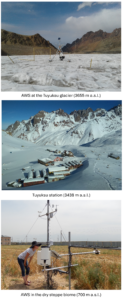
The Tuyuksu Observatory is located in the Ile Alatau, Kazakhstan and is run by the Central Asia Regional Glaciological Centre Under the Auspices of UNESCO. The Observatory was established in 1957 as a glaciological station measuring mass balance of the Tuyuksu glacier (one of the World Glacier Monitoring Service reference glaciers). In 1974, meteorological station was established at 3438 m a.s.l. near the Tuyuksu glacier tongue which is now more than one kilometre away from the station. Tuyuksu is the only site in the post-Soviet Central Asia which holds an uninterrupted long-term record of mass balance measurements. It is one of very few stations in Central Asia providing continuous, long-term meteorological measurements above 3000 m a.s.l. In 2015, the scope of monitoring was expanded, and equipment updated in the course of the bilateral UK – Kazakhstan research project ‘Climate Change, Water Resources and Food Security in Kazakhstan’ funded by the UK Newton Fund and led by the University of Reading. This and many other national and international projects enabled the development of the observatory conducting multidisciplinary monitoring in the Ile Alatau and on the adjacent plain.
Currently, the Tuyuksu Observatory includes three field stations, Tuyuksu (3438 m.s.l.) in the headwaters of the Kishi Almaty, the Big Almaty Lake (2500 m.a.s.l.) and Zhosaly Kezen (3300 m a.s.l.) in the Ulken Almaty valley. The monitoring domain extends between approximately 700 m a.s.l. (dry steppe biome) and 4000 m a.s.l. (glaciers). In addition to the Tuyuksu manual meteorological station, the observatory runs three automatic weather stations (AWS) with a range of meteorological, snow and soil sensors, hosts several WMO stations with records dating back to the 1930s and AWS and river flow gauges run by the Kazakhstan National Hydrometeorological Service.
The Tuyuksu Observatory conducts regular surveys of glaciers and rock glaciers using in situ, UAV and space-borne sensors (Kapitsa et al., 2020). It measures snow depth, Snow Water Equivalent (SWE), and temperature of permafrost at several locations. It conducts regular bathymetric surveys of glacier lakes (Kapitsa et al., 2023) supporting the Kazakhstan State Agency for Mudflow Protection. It runs continuous isotope and hydrochemistry sampling programme collecting precipitation (Saidaliyeva et al., 2023), river water and cryosphere samples. Tuyuksu is the only CAMON observatory providing data from its lower-elevation sites for research in agroclimatology, crop and agricultural water use modelling.
Both monitoring and research which the Tuyuksu Observatory conducts on climate and glacier change, water security and environmental quality are regularly reported by the media, most notably, by The New York Times.

